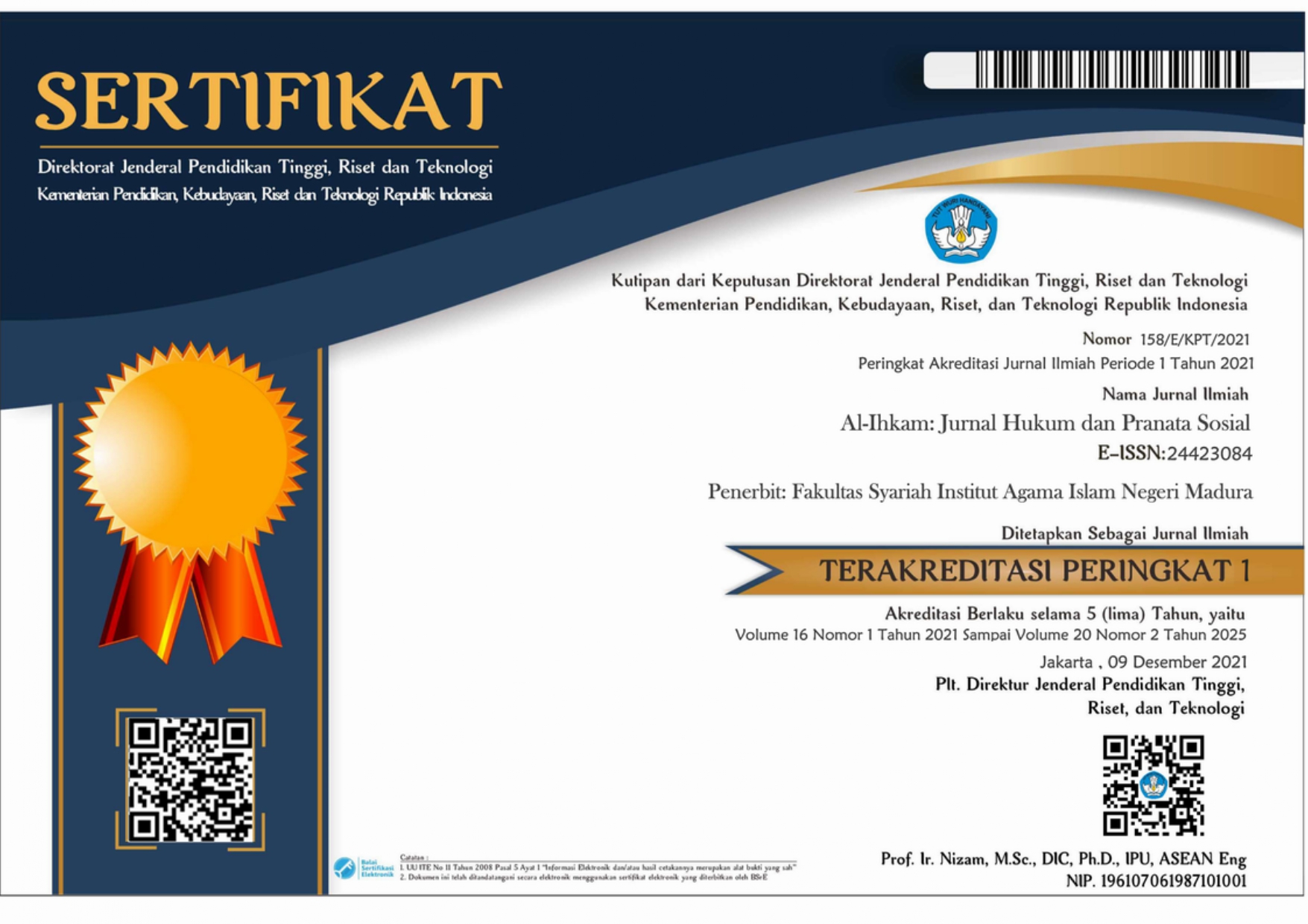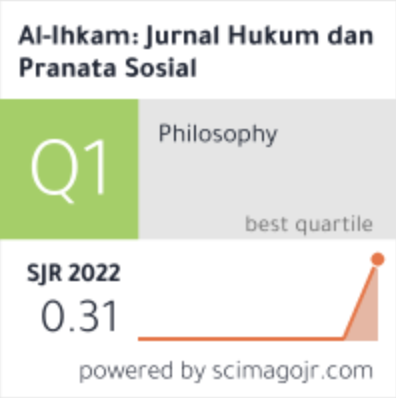Belo Bellen as Compulsory Delivery in Aceh Singkil Wedding; ‘Urf and Islamic Law Anthropology Review
 Abstract views: 363
,
Abstract views: 363
,
 PDF downloads: 221
PDF downloads: 221
Abstract
This article aims to discuss belo bellen (big betel) as a mandatory delivery for the groom to the bride in the community of Gunung Meriah District, Aceh Singkil Regency. It is delivered at the time of mengarak (providing the groom to the residence of the bride’s parents) of the wedding reception. This research is qualitative with an ethnographic approach. Data collection techniques were through in-depth interviews and observation supported by relevant literature data. Data were then analyzed qualitatively, namely through data condensation and presentation then and drawing. This research found that mandatory belo bellen delivery has been practiced for a long time and therefore becomes one of the legacies. Belo bellen take and give is made on the second night of the wedding party, attended by women. The function of belo bellen is to fulfill the custom, namely giving souvenirs of big betel to the bride’s family. The tradition is considered as a good deed according to ‘urf (Islamic legal context). In the anthropology of Islamic law, the tradition reflects the legal culture, legal behavior, and legal views of Aceh Singkil people.
Downloads
References
Al-’Ajam, Rafiq. Mawsū’ah Muṣṭalaḥāt Uṣūl Al-Fiqh ’Inda Al-Muslimīn. Beirut: Maktabah Lubnan Nasyirun, 1998.
Arifin, Tajul. Antropologi Hukum Islam. Bandung: Pusat Penelitian dan Penerbitan UIN Sunan Guung Djati Bandung, 2016.
Artina, Dessy. “The Existence of Traditional Law on Ethical Marriage in Ganting Village, Salo District Linked to Islamic Law.” In Proceedings of the 2nd Riau Annual Meeting on Law and Social Sciences (RAMLAS 2021), 659:18–22, 2022. https://doi.org/10.2991/assehr.k.220406.004.
Asa’ari, Asa’ari, Jafar Ahmad, Zufriani Zufriani, Doli Witro, and Muhamad Taufik Kustiawan. “Considering Death Penalty for Corruptors in Law on Corruption Eradication from the Perspective of Maqāsid ash-Syarī‘ah.” Samarah 7, no. 2 (2023): 920–36. https://doi.org/10.22373/sjhk.v7i2.14944.
Asmaret, Desi, Alaiddin Koto, and Afrizal. “Transformasi Hukum Keluarga Islam di Indonesia: Telaah Pemikiran Rifyal Ka’bah.” Al-Ahwal 12, no. 2 (2019): 145–60. https://doi.org/10.14421/ahwal.2019.12203.
Barkah, Qodariah. “Kedudukan dan Jumlah Mahar di Negara Muslim.” AHKAM : Jurnal Ilmu Syariah 14, no. 2 (2014): 279–86. https://doi.org/10.15408/ajis.v14i2.1286.
Chandra, Alya Nawa, and Gatot Efrianto. “Analisis Yuridis terhadap Uang Pelangkah Pernikahan Adat Betawi di Bekasi Ditinjau dari Hukum Adat dan Hukum Islam.” Jurnal Hukum Sasana 9, no. 2 (2024): 377–400. https://doi.org/10.31599/mmh32098.
Coontz, Stephanie. Marriage, a History: From Obedience to Intimacy, or How Love Conquered Marriage. New York: Penguin Book, 2005.
Dwiloka, Bambang, and Rati Riana. Teknik Menulis Karya Ilmiah. Jakarta: Rineka Cipta, 2005.
Efrinaldi, Jayusman, Shafra, and Nurfatati. “Urf Review of the Practice of Gold Marriage Mahar in the Community of Tanjung Senang District Bandar Lampung.” Al-Istinbath: Jurnal Hukum Islam 7, no. 1 (2022): 287–310. https://doi.org/10.29240/jhi.v7i1.4085.
Fetterman, David M. Etnografi Langkah Demi Langkah (Penerjemah) Anton Novenanto. Yogyakarta: Cantrik Pustaka, 2024.
Hasan, Abi. “Pandangan ’Urf terhadap Uang Pekhanjangan dalam Perkawinan Melangkahi Kakak Kandung.” Istinbath; Jurnal Hukum dan Ekonomi Islam 20, no. 1 (2021): 176–88.
Khairuddin, Khairuddin. Khazanah Adat dan Budaya Singkil: Mengungkap Keagungan Tradisi dan Memelihara Kebudayaan. Yogyakarta: Zahir Publishing, 2020.
Kusmayanti, Hazar, Dede Kania, Nanik Prasetyoningsih, and Zinatul Ashiqin Zainol. “Judges’ Acceptance of Sharia-Inspired Laws in Indonesia.” Al-Manahij: Jurnal Kajian Hukum Islam 17, no. 2 (2023): 199–214. https://doi.org/10.24090/mnh.v17i2.7716.
Maimun, Ach. “Memperkuat ’Urf dalam Pengembangan Hukum Islam.” Al-Ihkam: Jurnal Hukum & Pranata Sosial 12, no. 1 (2017): 22. https://doi.org/10.19105/al-ihkam.v12i1.1188.
Masputri, Siti Marlina. “Tinjauan Hukum Islam terhadap Pemberian Uang Adat (Selemak Semanis) dalam Perkawinan Adat Melayu Jambi.” ADHKI: Journal of Islamic Family Law 1, no. 1 (2019): 57–74. https://doi.org/10.37876/adhki.v1i1.2.
Miles, Matthew B., A. Michael Huberman, and Johnny Saldaña. Qualitative Data Analysis: A Methods Sourcebook. California, 2014.
Mustika, Dian, and Siti Marlina. “Integrated Marriage Itsbat in Jambi City: Analyzing the Problems behind Its Implementation.” Mazahib Jurnal Pemikiran Hukum Islam 18, no. 1 (2019): 44–75. https://doi.org/10.21093/mj.v18i1.1344.
Nasir, Mohamad Abdun. “Negotiating Muslim Interfaith Marriage in Indonesia: Integration and Conflict in Islamic Law.” Mazahib Jurnal Pemikiran Hukum Islam 21, no. 2 (2022): 155–86. https://doi.org/10.21093/mj.v21i2.5436.
Rizki, Annisa, and Aslam Nur. “Philosophical Meaning of Traditional Wedding Rituals of the Singkil Tribe.” Indonesian Journal of Islamic History and Culture 5, no. 1 (2024): 51–59. https://doi.org/https://doi.org/10.22373/ijihc.v5i1.4740.
Roslaili, Yuni. “Kajian ‘Urf tentang Adat Ranub Kong Haba dan Akibat Pembatalannya di Aceh.” Samarah 3, no. 2 (2019): 417–37. https://doi.org/10.22373/sjhk.v3i2.5192.
Sanjaya, Umar Haris, and Aunur Rahim Faqih. Hukum Perkawinan Islam. Yogyakarta: Gama Media, 2017.
Sheikh, Irum, Hafeez-ur-Rehman, and Arab Naz. “An Ethnographic Study of Marriage System and the Runaway Brides of Kalash.” Middle East Journal of Scientific Research 16, no. 10 (2013): 1393–1402. https://doi.org/10.5829/idosi.mejsr.2013.16.10.11990.
Siregar, Jenny Sista, and Lulu Hikmayanti Rochelman. “Seserahan dalam Perkawinan Adat Betawi: Sejarah dan Makna Simbolis.” Jurnal Ilmu Sosial dan Humaniora 4, no. 1 (2021): 67. http://jayapanguspress.penerbit.org/index.php/ganaya.
Siregar, Ramadhan Syahmedi, Muhammad Syakban, and Muhammad Ikhlas Bin Rosele. “The Role of Marriage Guardian of the Same Clan in the Traditional Marriage of Batak Toba Muslims in Samosir Regency in the Perspective of Islamic Law.” Al-Manahij: Jurnal Kajian Hukum Islam 17, no. 1 (2023): 41–52. https://doi.org/10.24090/mnh.v17i1.6750.
Syarifudin, Syarifudin, M. Mujib Qalyubi, and Irfan Hasanudin. “Tinjauan Hukum Islam terhadap Prosesi Seserahan dalam Pernikahan Adat Betawi (Studi Kasus Masyarakat Betawi Kedoya Selatan Kecamatan Kebon Jeruk, Kota Adm. Jakarta Barat).” Mozaic Islam Nusantara 5, no. 2 (2019): 103–30. https://doi.org/https://doi.org/10.47776/mozaic.v5i2.141.
Taufika, Ryan, Tohap Pandapotan Simaremare, Vinda Chairunnisa, and Tengku Syarifah Nadhira. “Overview of Traditional Law in the Use of Mayam as Mahar in Aceh Traditional Marriage.” Jurnal Civics: Media Kajian Kewarganegaraan 18, no. 2 (October 2021): 296–303. https://doi.org/10.21831/jc.v18i2.44945.
Tri Nugroho, Agung. “Seserahan dalam Perkawinan Adat Lampung Lampung.” Sabda 14, no. 1 (2019): 31–41. https://doi.org/https://doi.org/10.14710/sabda.14.1.31-41.
Yusuf, Januddin Muhammad, and Nawir Yuslem. “Acehnese Dayah Ulama’s Response to the Use of ’Urf in Istinbath of Fiqh Law from Islam Nusantara.” Al-Istinbath: Jurnal Hukum Islam 8, no. 1 (2023): 291–306. https://doi.org/10.29240/jhi.v8i1.5732.
Copyright (c) 2024 AL-IHKAM: Jurnal Hukum & Pranata Sosial

This work is licensed under a Creative Commons Attribution-ShareAlike 4.0 International License.
In order to be accepted and published by Al-Ihkam: Jurnal Hukum dan Pranata Sosial, author(s) submitting the article manuscript should complete all the review stages. By submitting the manuscript, the author(s) agreed to the following terms:
- The copyright of received articles shall be assigned to Al-Ihkam: Jurnal Hukum dan Pranata Sosial as the publisher of the journal. The intended copyright includes the right to publish articles in various forms (including reprints). Al-Ihkam: Jurnal Hukum dan Pranata Sosial maintain the publishing rights to the published articles.
- Authors are permitted to disseminate published articles by sharing the link/DOI of the article at Al-Ihkam: Jurnal Hukum dan Pranata Sosial. Authors are allowed to use their articles for any legal purposes deemed necessary without written permission from Al-Ihkam: Jurnal Hukum dan Pranata Sosial with an acknowledgment of initial publication to this journal.
- Users/public use of this website will be licensed to CC-BY-SA.



.png)
_1.png)










